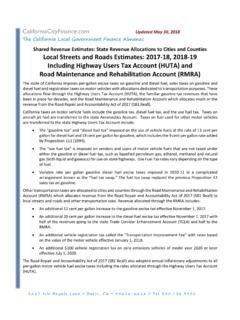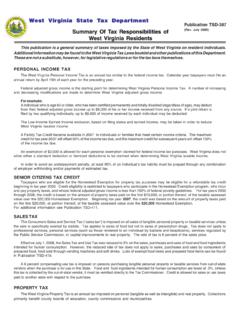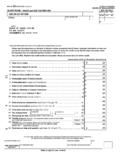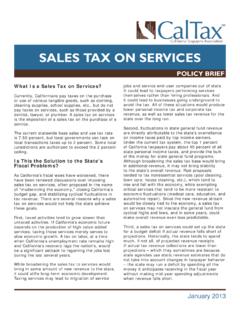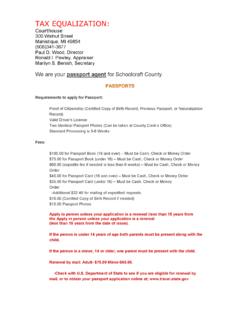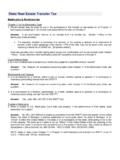Transcription of Prop Tax In Missouri - Stone County,Mo
1 The Property Tax in Missouri This brochure is designed to give taxpayers an understanding of the way property taxes are assessed and levied in Missouri , and how they affect individual taxpayers. A separate brochure describing the appeals process is available from the State Tax Commission. Brad Hudson Stone county Assessor Box 135, Galena MO 65656-0135 Phone: (417) 357-6141 or 357-6145 *======================================= =====* The Property Tax Although other taxes have proliferated in recent years, the property tax remains a mainstay of local government finance in Missouri . It provides a major source of revenue for most local governments, and will continue to be important to them.
2 The property tax gives local taxpayers a measure of control over their local governments. Local governments retain a greater measure of their autonomy when they can rely on property taxes. This tax provides a relationship to services received, such as police and fire protection and local streets, although it does so imperfectly. Everyone pays this tax, either directly or indirectly, and its revenues would be very difficult to replace from other revenue sources. More than 2,500 Missouri local governments rely on property taxes. They received more than $ billion in property taxes in 1997. The taxes were levied on an assessed valuation of $ billion, 25% of which was personal property and 75% was real estate.
3 Because of new construction, and increased values, assessed valuations grew an average of 6% a year from 1985, when the first statewide reassessment was completed, to 1997. During that time, taxes levied grew by an average 10% a year. The difference between those percentages is reflective of the tax rate increases adopted by local governments and their voters, and creation of some new local governments. How the Tax Is Determined The amount of property taxes imposed on any taxpayer is determined by two separate factors: (1) The assessed value of their taxable property, as established by the local assessor, and (2) The total of the tax rates that have been set by the several governing bodies of local governments where the property is located.
4 In setting values, the assessor is bound by laws and rules designed to assure that assessments are as 'uniform as possible. Once the assessor arrives at the total value of the taxpayer's taxable real and personal property, he/she calculates the portion that is assessed value by multiplying total value by the percentages set in the law for each type of property. Tax rates that have been set by the local governments taxing the property are multiplied by the assessed value and divided by 100. The result is the amount of tax levied against the property. Property is assessed at differing percentages of value according to type of property or its use. The statutes provide that all property improved by a structure which is used or intended to be used as a residence, is to be classified as residential.
5 Agricultural property must be devoted primarily to raising crops, livestock, dairying, etc. Real property is assessed: Residential 19% of Value Agricultural 12%1 All Other 32% of Value Personal property is assessed: Manufactured Homes 19% of Value Farm Machinery, Livestock 12% of Value Historic Cars, Planes .5% of Value Crops (Grain) .5% of Value Vehicles, Other of Value Example: Homeowner's Tax Bill A homeowner with a $50,000 house and two cars worth a total of $15,000, living in an area where the tax rates levied by local governments (including the state 3-cent levy) total $ per $100 assessed valuation, would have taxes calculated: Full Value Assessed Home $50,000 x 19% = $ 9,500 Cars $15,000 x = $5,000 Total Assessed Valuation $14,500 Times Tax Rate, per $1002 x.
6 0570 Tax levied $ The Assessment Cycle Personal property is assessed each year. Assessment lists are filed by taxpayers with the assessor after January 1, and before March 1. In most counties, the taxpayer is required to list the make, model and age of autos, and purchase price and year of purchase for machinery, office equipment, etc. Price guides are used for autos and other personal property where available, and depreciation schedules are applied to property for which price guides are not appropriate. The assessor determines the value and sub-classification of real property; it is assessed on an every-other-year basis, with values placed on the tax rolls each odd-numbered year.
7 Physical changes made to property can be reflected on the tax rolls in even numbered years; changes due to such things as market conditions may not be. If the value of the real property is an increase over the prior year, a notice of the increase is sent to the taxpayer. Approaches to Appraisal In valuing real estate, except farmland, the assessor uses one or more of three methods of measuring value, whichever is most appropriate for the property being assessed. They are (1) market approach, (2) cost approach, and (3) income approach. Market Approach: Fair market sales of comparable property are compared with the property, using recent arms-length sales of property in the vicinity.
8 Adjustments are made for differences in the properties. Cost Approach: Considers cost of material and labor to replace the property being valued. An allowance for accumulated depreciation is applied to arrive at a value. Income Approach: Net income from rent is converted into a potential worth. Operating expenses are deducted from gross revenues, and the result is capitalized to produce an indication of value. Farmland Valuation: Farmhouses and up to five acres are assessed in the same manner as other homes, at 19% of value; farm buildings are given a value in the same manner as buildings elsewhere, but at 12% of value; farmland itself is graded by the assessor, from grade 1 to grade 8, Each grade has a value certified by the Tax Commission, based on a University study, currently ranging from $985 per acre for grade 1 to $30 per acre for grade 8.
9 Statutes call for vacant and unused farmland to be assessed according to its market value. Who Is Liable For The Tax? Real Property: The liability for taxes levied against real property remains with the property. Taxes become a lien. If the property changes ownership, the new owner becomes liable for any unpaid taxes. If taxes are not paid, the property can be sold to satisfy the unpaid taxes and any other liens. Personal Property: Taxes due on personal property remain the responsibility of the taxpayer who owned the property on assessment date. If not paid, these taxes and penalties can be recovered by civil suit. Most personal property is taxed in the county and city where the taxpayer lives.
10 There are a few exceptions. Corporate property, houseboats, cabin cruisers, floating boat docks and manufactured homes are assessed where they are located on January 1. Personal property of Missouri residents located outside the state is not assessed in this state and that owned by non-residents located in the state is taxed in the county where it is located on January 1. Taxation of the personal property of Military personnel is governed by a federal law, enacted in 1940 to prevent double taxation. It provides that their property is to be taxed by the military person's county of residence-the county from which they entered service-no matter where they or their property is located.


